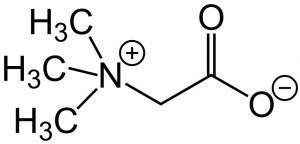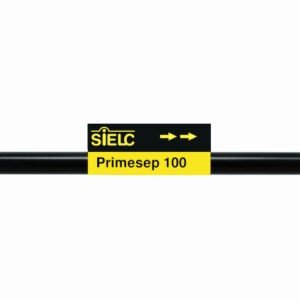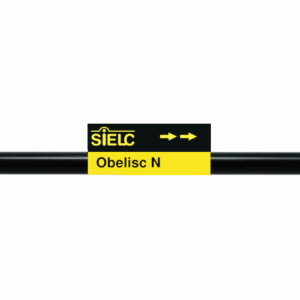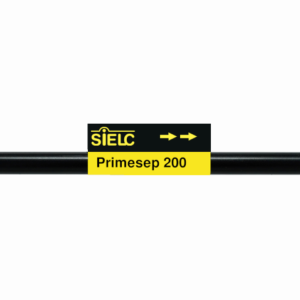| CAS Number | 107-43-7 |
|---|---|
| Molecular Formula | C5H11NO2 |
| Molecular Weight | 117.148 |
| InChI Key | KWIUHFFTVRNATP-UHFFFAOYSA-N |
| LogP | -2.72 |
| Synonyms |
|
Applications:
HPLC MS Method for Analysis of Trimethylglycine (Betaine) on Primesep 100 Column
January 18, 2024
HPLC Method for Analysis of Betaine on Primesep 100 by SIELC Technologies
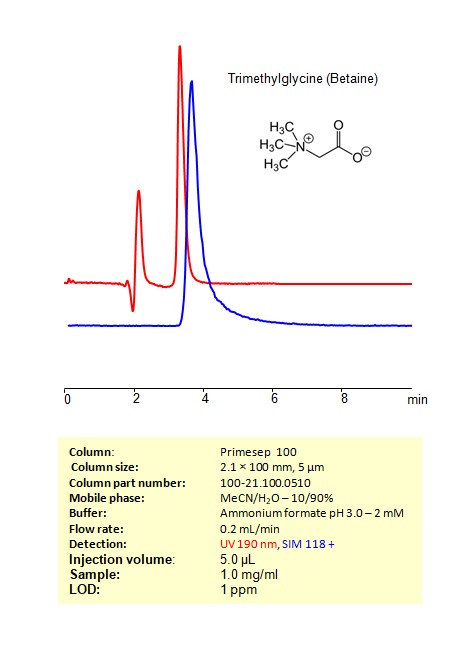
High Performance Liquid Chromatography (HPLC) Method for Analysis of Betaine
Trimethylglycine, also known as betaine, is a compound derived from the amino acid glycine. It is found in various foods, including beets, spinach, whole grains, and seafood. Trimethylglycine has been studied for its potential health benefits, and it is commonly used as a dietary supplement.
Methylation Support: Trimethylglycine plays a role in a process called methylation, which is important for various biochemical reactions in the body. Methylation is involved in the synthesis of neurotransmitters, DNA, and proteins.Heart Health: Some studies suggest that trimethylglycine may have potential benefits for heart health. It is believed to help lower levels of homocysteine, an amino acid linked to an increased risk of heart disease when present in high concentrations.
Exercise Performance: There is some evidence suggesting that trimethylglycine supplementation may enhance exercise performance. It is thought to improve oxygen utilization and reduce fatigue during physical activity.
Liver Health: Trimethylglycine has been investigated for its potential to support liver health. It may help protect the liver from certain forms of damage.
Anti-Inflammatory Properties: Some studies propose that trimethylglycine may have anti-inflammatory effects, which could be beneficial in various health conditions.
Trimethylglycine can be retained and analyzed using a Primesep 100 mixed-mode stationary phase column. The analysis employs an isocratic method with a simple mobile phase consisting of water, acetonitrile (MeCN), and ammonium formate as a buffer. Detection is achieved using UV at 190 nm and SIM 118+
| Column | Primesep 100, 2.1 x 100 mm, 5 µm, 100 A |
| Mobile Phase | MeCN/H2O – 10/90% |
| Buffer | Ammonium formate pH 3.0 – 2 mM |
| Flow Rate | 0.2 ml/min |
| Detection | UV 190 nm, SIM 188+ |
| Samples | 1 mg/mL |
| Injection volume | 1 µl |
| LOD* | 1 ppm |
| Class of Compounds | Quaternary ammonium |
| Analyzing Compounds | Betaine |
Application Column
Primesep 100
Column Diameter: 2.1 mm
Column Length: 100 mm
Particle Size: 5 µm
Pore Size: 100 A

HPLC Method for Analysis of Trimethylglycine (Betaine) on Primesep 100 Column
January 17, 2024
HPLC Method for Analysis of Betaine on Primesep 100 by SIELC Technologies
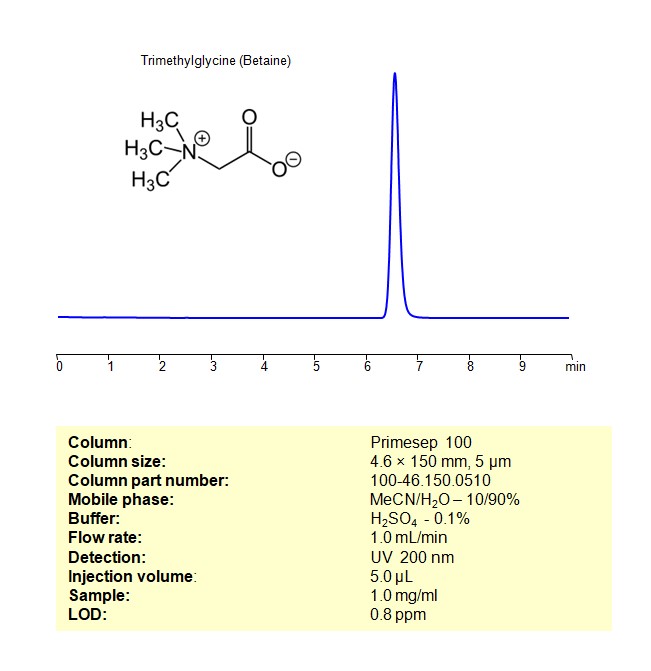
High Performance Liquid Chromatography (HPLC) Method for Analysis of Betaine
Trimethylglycine, also known as betaine, is a compound derived from the amino acid glycine. It is found in various foods, including beets, spinach, whole grains, and seafood. Trimethylglycine has been studied for its potential health benefits, and it is commonly used as a dietary supplement.
Methylation Support: Trimethylglycine plays a role in a process called methylation, which is important for various biochemical reactions in the body. Methylation is involved in the synthesis of neurotransmitters, DNA, and proteins.Heart Health: Some studies suggest that trimethylglycine may have potential benefits for heart health. It is believed to help lower levels of homocysteine, an amino acid linked to an increased risk of heart disease when present in high concentrations.
Exercise Performance: There is some evidence suggesting that trimethylglycine supplementation may enhance exercise performance. It is thought to improve oxygen utilization and reduce fatigue during physical activity.
Liver Health: Trimethylglycine has been investigated for its potential to support liver health. It may help protect the liver from certain forms of damage.
Anti-Inflammatory Properties: Some studies propose that trimethylglycine may have anti-inflammatory effects, which could be beneficial in various health conditions.
Trimethylglycine be retained and analyzed using a Primesep 100 mixed-mode stationary phase column. The analysis employs an isocratic method with a simple mobile phase comprising water, acetonitrile (MeCN), and sulfuric acid as a buffer. This method allows for detection using UV at 200 nm
| Column | Primesep 100, 4.6 x 150 mm, 5 µm, 100 A |
| Mobile Phase | MeCN/H2O – 10/90% |
| Buffer | H2SO4 -0.2% |
| Flow Rate | 1.0 ml/min |
| Detection | UV 200 nm |
| Samples | 1 mg/mL |
| Injection volume | 5 µl |
| LOD* | 0.8 ppm |
| Class of Compounds | Aromatic amines, Ureas |
| Analyzing Compounds | Betaine |
Application Column
Primesep 100
Column Diameter: 4.6 mm
Column Length: 150 mm
Particle Size: 5 µm
Pore Size: 100 A

HILIC Separation of Carboxymethylcysteine and Betaine
August 22, 2008
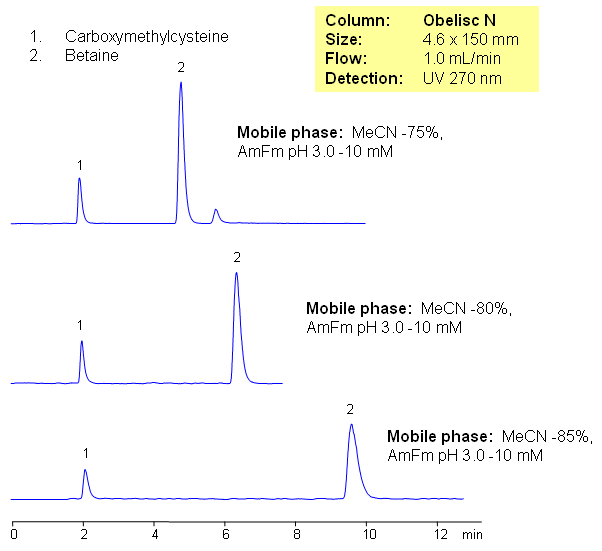
In this HPLC method, betaine and carboxymethylcysteine are separated by HILIC mixed-mode mechanism. Betaine and carboxymethylcysteine are very hydrophilic compounds which are not retained on reverse phase columns. Compounds are separated by combination of HILIC and ion-exchange mechanisms. In HIILIC mode, Obelisc N columns allow operating at lower organic concentration for improved solubility of analytes. Method can be used for quantitative or qualitative analysis of betaine and carboxymethylcysteine using ESLD or LC/MS detection. Betaine in chemistry is any neutral chemical compound with a positively charged cationic functional group such as ammonium ion or phosphonium ion (generally: onium ions) which bears no hydrogen atom and with a negatively charged functional group such as a carboxylate group which may not be adjacent to the cationic site. Historically the term was reserved for tetramethylglycine only.
Application Column
Obelisc N
SIELC has developed the Obelisc™ columns, which are mixed-mode and utilize Liquid Separation Cell technology (LiSC™). These cost-effective columns are the first of their kind to be commercially available and can replace multiple HPLC columns, including reversed-phase (RP), AQ-type reversed-phase, polar-embedded group RP columns, normal-phase, cation-exchange, anion-exchange, ion-exclusion, and HILIC (Hydrophilic Interaction Liquid Chromatography) columns. By controlling just three orthogonal method parameters - buffer concentration, buffer pH, and organic modifier concentration - users can adjust the column properties with pinpoint precision to separate complex mixtures.
Select optionsCarboxymethylcysteine
UV Detection

Retention Characteristics of Betaine in Mixed-Mode HPLC
May 5, 2005
The retention of the zwitterion betaine on Primesep 200 demonstrates the tunability of Primesep columns. Retention of betaine is altered by acid type, amount of acid in the mobile phase, and the amount of organic solvent. Typical reversed-phase columns do not show this tunability with simple mass spec compatible mobile phases of water, acetonitrile (MeCN, ACN) and trifluoracetic acid (TFA) with evaporative light scattering detection (ELSD).
Application Column
Primesep 200
The Primesep family of mixed-mode columns offers a wide variety of stationary phases, boasting unprecedented selectivity in the separation of a broad array of chemical compounds across multiple applications. Corresponding Primesep guard columns, available with all stationary phases, do not require holders. SIELC provides a method development service available to all customers. Inquire about our specially-tailored custom LC-phases for specific separations.
Select optionsQuaternary Amines
Zwitterion

